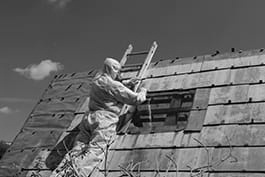Profession asbestos abatement worker

Asbestos removal workers remove asbestos from buildings and facilities.
Would you like to know what kind of career and professions suit you best? Take our free Holland code career test and find out.
Personality Type
Tasks asbestos abatement worker
- Prepare work sites, e.g. erect barriers and scaffolding.
- Select or request equipment and machines, transport and set them up.
- Locate the indentified asbestos that needs to be removed, e.g. using monitoring devices.
- Wear respirators for protection from dangerous airborne particles and suits that completely protect from hazardous materials (e.g. disposable or reusable overalls, gloves, hardhats, shoe covers, safety glasses or goggles, chemical-resistant clothing, face shields and devices to protect hearing).
- Perform demolition and deconstruction work.
- Remove asbestos from the surfaces of walls and structures, using various hand and power tools (e.g. vacuums and scrapers).
- Package, transport and dispose of asbestos in a safe manner.
- Respond to accidents and emergencies, and clean up after accidents.
Related professions hazardous materials
- Removal worker, all other hazardous materials
Knowledge
- Asbestos removal regulations
The legislation and regulations surrounding the removal of asbestos contamination from buildings or structures, the safe removal of contaminated materials and the regulations to avoid and prevent contamination.
- Health, safety and hygiene legislation
The set of health, safety and hygiene standards and items of legislation applicable in a specific sector.
- Contamination exposure regulations
The regulations concerning exposure to contaminated materials or a hazardous environment which regulate the actions surrounding risk assessment, minimisation of further exposure, quarantine, and treatment of the exposed persons.
Skills
- Store contaminated materials
Package and store materials which pose risks to health and safety due to contamination, and awaiting disposal or treatment, in a manner compliant with safety regulations.
- Disinfect surfaces
Apply the correct cleaning procedures, taking into account safe handling of disinfectants, to remove contaminants, pollutants, and bacterial risks, from various surfaces, such as buildings exteriors, vehicles, and roads.
- Use personal protection equipment
Make use of protection equipment according to training, instruction and manuals. Inspect the equipment and use it consistently.
- Investigate contamination
Perform tests to investigate the properties of contamination in an area, or on surfaces and materials, in order to identify the cause, its nature, and the extent of the risk and damage.
- Assess contamination
Analyse evidence of contamination. Advise on how to decontaminate.
- Avoid contamination
Avoid the mixing or contamination of materials.
- Remove contaminants
Use chemicals and solvents to remove contaminants from products or surfaces.
- Remove contaminated materials
Remove materials and equipment which are contaminated with hazardous substances in order to protect the surroundings from further contamination and to treat or dispose of the contaminated materials.
Optional knowledge and skills
assess waste type use solvents ensure operability of protective equipment follow safety procedures when working at heights assist people in contaminated areas hazardous waste storage perform demarcation operate pressure washer ensure compliance with waste legislative regulations dispose of hazardous waste hazardous materials transportation handle chemical cleaning agents hazardous waste treatment report on building damage identify damage to buildings secure working areaSource: Sisyphus ODB